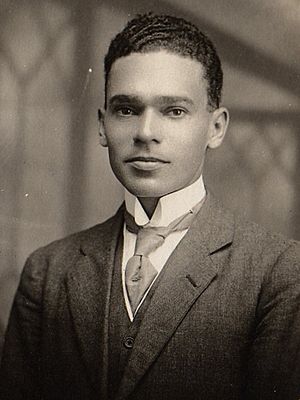William Robinson Clarke facts for kids
Quick facts for kids
William Robinson Clarke
|
|
|---|---|

Clarke, c. 1914
|
|
| Nickname(s) | Robbie |
| Born | 4 October 1895 Kingston, Jamaica |
| Died | 26 April 1981 (aged 88) Kingston, Jamaica |
| Buried |
Military Cemetery at Up Park Camp, Kingston, Jamaica
|
| Allegiance | United Kingdom |
| Service/ |
Royal Flying Corps |
| Years of service | 1915–1919 |
| Rank | Sergeant |
| Unit | No. 4 Squadron RAF No. 254 Squadron RAF |
| Battles/wars | World War I |
| Awards | Silver War Badge |
| Other work | Builder |
Sergeant William Robinson Clarke was a brave Jamaican airman. He was born on October 4, 1895, and passed away on April 26, 1981. He made history as the very first black pilot to fly for Britain during World War I.
Contents
Early Life in Jamaica
William Robinson Clarke was born in Kingston, Jamaica. His mother's name was Eugenia Clarke. As he grew up, he became a skilled mechanic. He was also one of the first people in Jamaica to learn how to drive a car!
Flying in World War I
When World War I started in 1914, William was 19 years old. He decided to travel to England all by himself. He paid for his own journey to join the war effort.
Joining the Royal Flying Corps
On July 26, 1915, William joined the Royal Flying Corps. This was Britain's air force at the time. He first worked as a mechanic, fixing aircraft. Later, he drove vehicles for a company that used observation balloons. These balloons helped soldiers see what the enemy was doing.
Becoming a Pilot
In December 1916, William began his pilot training. He worked hard and earned his pilot's "wings" on April 26, 1917. This meant he was ready to fly planes in combat. He was promoted to Pilot Sergeant.
Flying Over the Western Front
Soon after, on May 27, 1917, Sergeant Clarke was sent to No. 4 Squadron RAF. This squadron was based at a place called Abeele. He flew R.E.8 biplanes. These were planes with two sets of wings. He flew them over the Western Front, which was the main battle area in Europe.
A Dangerous Mission
On July 28, 1917, Sergeant Clarke was on a mission. He was flying with his observer, Second Lieutenant F. P. Blencowe. They were taking photographs behind the German lines near Ypres. Suddenly, about five German scout planes attacked them!
William was seriously wounded during the attack. He got a bullet through his spine and lost consciousness. But his observer, Lieutenant Blencowe, was unharmed. He managed to fly the damaged plane back across the British lines. He then made a safe landing near Godewaersvelde.
William later wrote to his mother about the event:
"I was doing some photographs a few miles the other side when about five Hun scouts came down upon me, and before I could get away, I got a bullet through the spine. I managed to pilot the machine nearly back to the aerodrome, but had to put her down as I was too weak to fly any more … My observer escaped without any injury."
Recovery and Discharge
Sergeant Clarke recovered from his serious injuries. However, he could no longer fly planes. He returned to duty as a mechanic with No. 254 Squadron RAF in England. In 1919, he was honorably discharged from the military. He received the Silver War Badge for his service.
Life After the War
After recovering, William Robinson Clarke returned home to Jamaica. The government paid for his journey back. He later worked in the building trade, helping to construct buildings. He also stayed involved with groups for war veterans. He became the life president of the Jamaican branch of the Royal Air Forces Association. This group supports people who served in the Royal Air Force.
Remembering William Clarke
In 2021, the Imperial War Museum announced something special. They added an identification bracelet that belonged to William Clarke to their collections. This helps people remember his important contributions.
See also
- Eugene Bullard, the first African-American military pilot, who flew for France.
- Ahmet Ali Çelikten of the Ottoman Empire.
- Domenico Mondelli in Italy.

